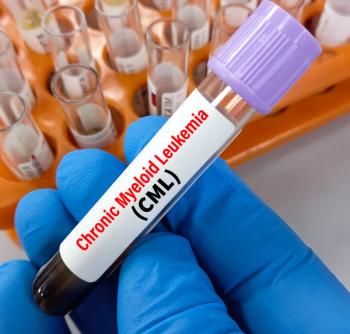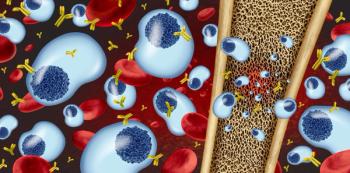
- Volume 0 0
BCG: The Current Treatment of Choice for Bladder Cancer
Mr. Sherman is president of Sherman Consulting Services Inc.
After arecent physical examination,my wife learned that redand white blood cells weredetected in her urine. The doctorordered an intravenous pyelogram todetermine the cause. In this test, aniodine-containing contrast material isinjected into the bloodstream, and aseries of x-rays is then taken at timedintervals. The resulting films allow theradiologist to view the entire urinarytract. Unfortunately, the diagnosis revealedthat my wife had bladder cancer,a well-differentiated papillary tumor,which fortunately could be completelyremoved by transurethral resection andfulguration.
The urologist told us that a high-gradetransitional type of tumor would requirethe instillation of chemotherapeuticdrugs such as mitomycin C or doxorubicin.Another option would be to useBacille Calmette-Gu?rin (BCG) vaccineinstillations?-a treatment that controlssuperficial bladder cancer, particularlycarcinoma in situ. I was surprised tolearn that an ancient vaccine, originallydesigned to prevent tuberculosis (TB), isemployed for a completely unrelatedindication and is the current treatment ofchoice for bladder cancer. I thought thatother pharmacists might be as curious asI was to learn more about the drug, itsdiscovery, and its alternative use.History?Tuberculosis
Live attenuated BCG vaccine is indicatedfor the prevention of disease associatedwith Mycobacterium tuberculosis. In1904, the organism destined to be usedfor the vaccine was isolated from a caseof TB in cattle. The culture was highly virulentfor many types of animals, andprobably for humans, but it became progressivelyweakened while being cultivatedin the test tube by French bacteriologistsAlbert Calmette and CamilleGu?rin.1
This cultivation required 231 passagesthrough the laboratory over a period of13 years. Because of the inability to preserveviable bacteria (by freezing), thislive vaccine required continued passage,eventually resulting in a profusion of phenotypicallydifferent daughter strains.2This special Mycobacterium bovis strainwas named in honor of the researchers.3
Once they were convinced of the safetyand immunizing power of BCG in animals,Calmette and his collaboratorsconducted a large program of vaccinationof children born into tuberculousfamilies.4 At first, the vaccine was administeredby mouth and only to newborninfants.1 Now, the method most commonlyused consists of injecting the vaccineinto the superficial layers of the skinor depositing a drop ofit on the skin and prickingwith a sharp needle,as is done in smallpoxvaccinations.
At best, the vaccineis 80% effective in preventingTB for a durationof 15 years. Onethird of clinical trialshave shown no protectiveeffect, however.5
Despite the questionsabout its efficacy,only a few countries donot use BCG for routinevaccination. This situationmay change in thefuture, however, withrecent evidence thatolder versions of thevaccine may be moreeffective than some ofthe more recentstrains.6 In the UnitedStates, BCG generally isnot administered toadults, because it is feltthat having a reliable Mantoux test, andbeing able to accurately detect activedisease, is more beneficial to societythan vaccinating against a relatively rarecondition.5History?Bladder Cancer
At the beginning of the 20th century, itbecame known that TB patients wereless likely to contract cancer. Apparentlythe disease had an antitumor effect. Anautopsy series by Raymond Pearl atJohns Hopkins Hospital in 1929 was oneof the first reports that documented alower frequency of cancer in patientswith TB.3 The mechanism is unclear.
In the 1930s, the use of BCG as a cancertherapy was first raised, but therewas little attention or enthusiasm duringthe 1950s and 1960s. Further researchby Coe and Feldman rekindled interest,with the demonstration of a strongdelayed hypersensitivity reaction to BCGin the guinea pig bladder.7
In 1976, Morales, Eidinger, and Brucewere the first to report on successfultreatment of superficial bladder cancerwith intravesical (within the bladder)BCG.8 They were able to demonstrate aremarkable decrease in the rates ofrecurrence in 9 patients. A randomizedprospective trial by Donald Lamm andassociates in 1980 confirmed these earlierobservations.9
BCG is now regarded as the most successfulurologic immunotherapy fortreating cancer. It has become the treatmentof choice for high-risk superficialbladder cancer in most countries, and itis given at an increasing annual rate ofapproximately 1 million doses.2Mechanism of Action
The initial crucial step in BCG therapyseems to be the binding of mycobacteriato the urothelial lining?which dependson the interaction of a fibronectin attachmentprotein on the bacterial surfacewith the fibronectin in the bladder wall.The presence of BCG then leads to theactivation of urothelial and antigen-presentingcells.2 This action results in amassive local immune response (immunotherapy)characterized by inducedexpression of cytokines in the urine andbladder tissue, and an influx of granulocytesas well as mononuclear cells intothe bladder wall. After these events, amassive cellular infiltration is seen, andthis local inflammatory reaction in thebladder mucosa is characterized by largenumbers of T cells, both CD4 and CD8, aswell as macrophages.3
The contribution of CD4 T cells also ismarked by the secretion of cytokines,leading to the maturation of cytotoxic Tcells or possibly specific BCG-activatedkiller cells. The latter are capable of differentiatingbetween normal and tumorcells. Only viable BCG organisms caninduce the activity of the killer cells. Thisfact may explain why live attenuatedBCG is necessary for successful intravesicalBCG therapy.3
It is important to note that this activityin patients? bladders can persist for morethan 1 year after the initial 6-week therapeuticinduction course, but it commonlybegins to wane after 3 to 6 months. Thisresult provides the rationale for maintenancetherapy.Treatment Regimen
Standard treatment consists of a once-weeklyinstillation of BCG for 6 weeks.Patients are given live attenuated BCGmixed in 50 mL of normal saline, instilledinto the bladder via a urethral catheter.The patient retains the fluid within thebladder for an hour, and during this periodthe patient lies prone for 15 minutes,supine for 15 minutes, and on each sidefor 15 minutes. Alternatively, some urologistsrecommend that the instillation beretained in the bladder for 2 hours. Thisduration ensures that all of the bladdermucosa comes into contact with theBCG.
Caution is suggested in handling theBCG because of a small risk of TB infection.The staff administering the BCGshould be suitably protected with masks,goggles, gloves, and gowns to avoidinhalation and contact of BCG with brokenskin. All equipment, supplies, andreceptacles in contact with BCG shouldbe handled and disposed of as biohazardousmaterials.
Patients should be advised to pour 2cups of household bleach into their toiletsafter urinating to neutralize any BCGthat may be found in the urine. The medicationand bleach should remain in thetoilet for 15 to 20 minutes before flushing.Patients should be advised to washtheir hands and genital areas thoroughlyafter urinating and to drink plenty of fluidsafter each instillation to flush thebladder.
At the conclusion of the 6-weekcourse, the patient undergoes a cystoscopy.If the bladder is free of tumorrecurrence, then the patient is enteredinto a program of regular cystoscopic follow-up. If the tumor recurs, then thepatient can, after resection, have a furthercourse of BCG.3Side Effects and Contraindications
Specific side effects are common. Themost frequent are abacterial cystitis anddysuria, hematuria, and a low-gradepyrexia. These side effects usually subsidewithin a 48-hour period and requirelittle more than an analgesic for treatment.In these cases, BCG treatment cancontinue, but if the side effects are troublesome,increasing the time betweentreatments or reducing the dose shouldbe considered.
Contraindications include an impairedimmune response caused by disease,drugs, or other therapy; pregnancy andlactation; and positive HIV serology.References
1. Dubos R, Dubos J. The White Plague. New Brunswick, NJ: Rutgers University Press; 1952.
2. Bohle A, Sven B. Immune mechanisms in Bacillus Calmette Guerin immunotherapy for superficial bladder cancer. J Urol. 2003;170:964-969.
3. Meyer JP, Persad R, Gillatt DA. Use of bacille Calmette-Guerin in superficial bladder cancer. Postgrad Med J. 2002;78:449-454.
4. Fine PEM, Carneiro IAM, Milstien JB, Clements CJ. Issues relating to the use of BCG in immunization programmes. Geneva, Switzerland: World Health Organization; 1999.
5.
6. Brosch R, Gordon SV, Garnier T, et al. Genome plasticity of BCG and impact on vaccine efficacy. Proc Natl Acad Sci USA. 2007;104:5596-5601.
7. Coe JE, Feldman JD. Extracutaneous delayed hypersensitivity, particularly in guinea pig bladder. Immunology. 1966;10:127-136.
8. Morales A, Eidinger D, Bruce AW. Intracavity Bacille Calmette-Guerin in the treatment of superficial bladder tumors. J Urol.1976; 116:180-183.
9. Lamm DL, Thor DE, Harris SC, Reyna JA, Stogdill VD, Radwin HM. Bacille Calmette-Guerin immunotherapy of superficial bladder cancer. J Urol. 1980;124:38-40.
Articles in this issue
about 18 years ago
Calming the Symptoms of Menopauseabout 18 years ago
Zoster Vaccineabout 18 years ago
pharmacy TECHNOLOGY productsabout 18 years ago
health-systems PRODUCT newsabout 18 years ago
can you READ these Rxs?about 18 years ago
can you READ these Rxs?about 18 years ago
Generic Times Product Newsabout 18 years ago
compounding HOTLINEabout 18 years ago
Human HRT Leads Compounding Renaissanceabout 18 years ago
Prescription-overdose Deaths Surpass Car-accident DeathsNewsletter
Stay informed on drug updates, treatment guidelines, and pharmacy practice trends—subscribe to Pharmacy Times for weekly clinical insights.























































































































































































































